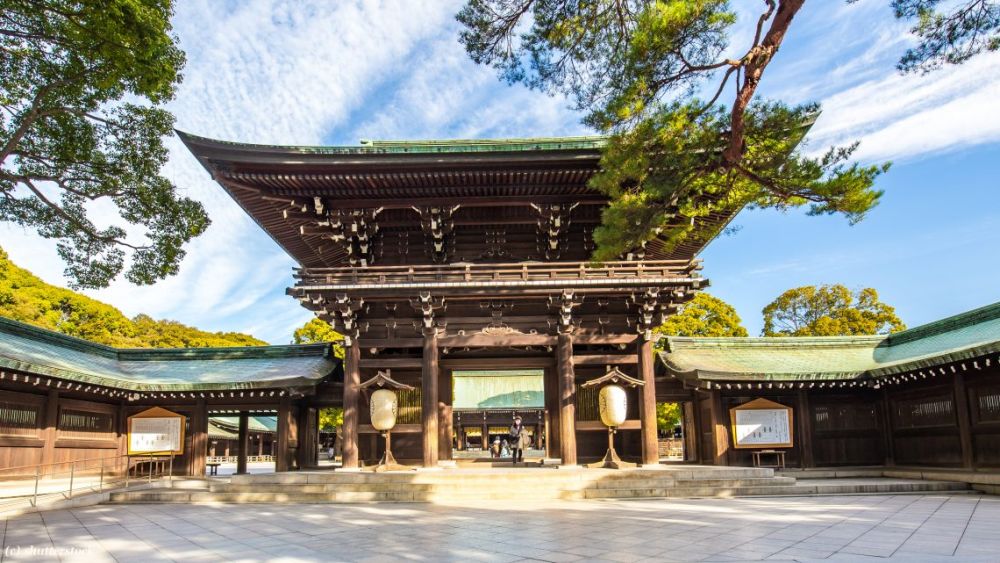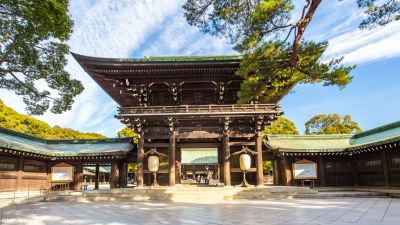

The Meiji Shrine, also known as Meiji Jingu, is one of Tokyo's most venerable Shinto shrines. This activity includes a guided tour that provides insightful background on the shrine's history and significance. Participants will learn about Emperor Meiji and Empress Shoken, in whose honor the shrine was established in 1920. A local guide will lead guests through the towering torii gates, along the serene paths of the evergreen forest that covers 170 acres surrounding the shrine. Visitors will experience Shinto traditions firsthand, learn about the religion's practices, such as purification rituals, offering prayers, and writing wish plaques called 'ema'. This tour is not only a cultural journey but also a visual feast, set amidst the shrine's tranquil gardens and grand architecture. It’s an opportunity to escape Tokyo's urban hustle and embrace the calm and spirituality of one of its most peaceful locales.
Experiencing one of Meiji Shrine's seasonal festivals is a unique cultural activity, with ceremonies that have been celebrated for many years. Visitors can witness events such as the Spring Grand Festival in April, the Autumn Grand Festival in November, and other various Shinto ceremonies and festivals held throughout the year. These festivals often involve traditional music, processions, and dances performed by shrine maidens known as 'miko'. They offer a vivid window into Japan's traditional customs and are a perfect occasion for visitors to not only enjoy but also learn about the enduring aspects of Japanese culture. The festivals reflect the nation’s close connection with nature and the changing seasons and are characterized by their solemnity, beauty, and festive atmosphere.
Within the spacious grounds of Meiji Shrine lies the Inner Garden, known as Yoyogi Gyoen. This secluded garden is a hidden gem where visitors can enjoy a leisurely stroll. The garden boasts a large variety of seasonal flowers and is particularly famous for its irises, which bloom in late June and early July. Guests can meander along the paths and across the small ponds and streams, taking in the harmonious blend of traditional Japanese garden design and the natural beauty. Kiyomasa’s Well, a historic spring praised for the purity of its water, is also a highlight of the garden. A visit to the Inner Garden offers a serene retreat from the buzz of the city and a chance to appreciate the historic and horticultural elements of the shrine.
Meiji Shrine offers visitors the chance to experience omikuji, a traditional Japanese fortune-telling ritual. Participants randomly select a paper slip that reveals their fortune, ranging from great blessing to great curse. It's an engaging part of Japanese culture, offering insights into the future concerning various aspects of life including health, wealth, love, and happiness. If the fortune is unfavorable, it is customary to tie the paper onto the designated racks or strings with other bad fortunes in the belief that the bad luck will be averted. This simple yet profound activity allows the participants a moment of contemplation and provides a personal connection to the spiritual environment of the shrine. It's a must-do for those looking to engage in the customs of the local culture.
Visitors to Meiji Shrine have the unique opportunity to witness traditional Shinto wedding ceremonies. It's common to see couples in ceremonial attire on weekends and holidays, as the shrine is a popular venue for weddings. The brides are often seen wearing beautiful white kimonos and elaborate headpieces, while the grooms wear traditional Montsuki haori hakama (formal kimono and trousers). Spectators can observe the wedding procession, as the couple and their families walk through the shrine's grounds, led by Shinto priests and shrine maidens, to the beat of Japanese taiko drums. While respectful silence is expected from onlookers, this activity gives visitors a rare glimpse into the customs and ceremonial attire of a traditional Japanese wedding.
Ema are small wooden plaques on which visitors can write their prayers or wishes and then leave them at the shrine in hopes that the deities will receive them. This activity allows individuals to partake in one of Japan's most cherished traditions. At Meiji Shrine, visitors can purchase an ema from the shrine office, write their message, and hang it on the designated wooden racks among thousands of others. It is a deeply personal experience that also connects participants with the community of worshipers and visitors from around the world. The ema are adorned with unique pictures and designs, often featuring the year’s Chinese zodiac animal, making them not only a spiritual token but also a keepsake or a memorable gift.
An activity that offers a deeper understanding of the shrine's history is a visit to the Meiji Shrine Treasure House. This museum houses personal belongings of Emperor Meiji and Empress Shoken, including robes, dishes, sacred treasures, and calligraphy by the emperor himself. The artifacts provide an intimate look into Meiji-era Japan and contribute to the overall appreciation of the shrine's significance. Constructed out of Japanese cypress, the Treasure House reflects traditional architectural styles and adds to the historical narrative of the shrine. For history buffs and those interested in the cultural heritage of Japan, the Treasure House presents a valuable and informative experience.
The Japanese tea ceremony, also known as the Way of Tea, is a traditional ritual influenced by Zen Buddhism where powdered green tea, or matcha, is ceremonially prepared by a skilled practitioner and served to a small group of guests in a tranquil setting. At Meiji Shrine, you can participate in a tea ceremony to experience the choreographed art of preparing and serving Japanese green tea. This peaceful ceremony fosters a reflective mind and a deeper understanding of Japanese culture. Guests sit on tatami mats and observe the elegant and deliberate process, learning about the utensils and techniques used to create the perfect bowl of matcha. The tea ceremony is a sensory experience that immerses participants in the aesthetics, tradition, and philosophy of Japan.
